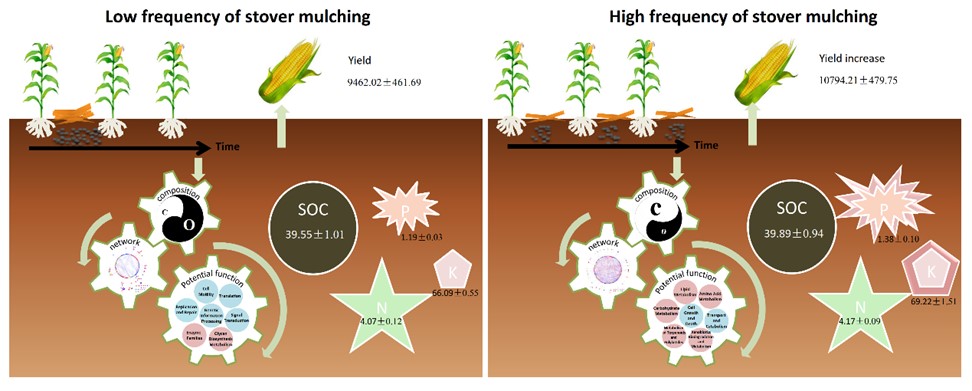Frequent Stover Mulching Builds Healthy Soil through Soil Bacterial Community
Soil health, which refers to a soil’s capacity to function as a vital living system according to its potential and changes over time, is the foundation of productive, sustainable agriculture. Conservation tillage, such as no-till and retention of crop residues, has been widely performed in global agricultural ecosystems to maintain soil health at a satisfactory state.
However, crop residues are also used for bioenergy production and livestock feeding. For this reason, it is important to determine which type of residues management can ensure soil health and meet our needs for plant production. It is unclear how the quantity and frequency of residue retention influences soil ecosystem. Therefore, we expect an optimal combination of quantity and frequency of stover mulching that will help to achieve a win-win solution to balance addition of corn stover with soil health and economic benefits.
A research team led by Liang Chao and Bao Xuelian from the Institute of Applied Ecology, Chinese Academy of Sciences recently conducted a 10-year experiment in China Mollisol to assess how the frequency and quantity of stover mulching affected the bacterial community, soil health, and crop productivity. The experiment included two-level frequencies and two-level quantities of maize stover mulching.
They found that frequency, rather than quantity, of stover mulching had a significant effect on the structure and functions of bacterial communities and maize production in agricultural soils. High frequency of stover mulching resulted in high bacterial community α-diversity, which was dominated by copiotrophs, associated with complex intense networks and more metabolic potential functions. Low frequency of stover mulching encouraged oligotroph-dominated bacterial communities, which were related to simple networks and more potential functions that involved cell processes. High frequency of stover mulching improved soil fertility and productivity by providing high nutrient availability and sustaining active bacterial communities.
When the stover quantity is limited, using small quantities for multiple additions can regenerate more stable and active bacterial communities, thereby improving soil fertility.
These findings highlight frequency of retaining residues in agricultural management should be considered, which can improve the efficiency of plant residues utilization. These findings provide a theoretical basis for specifying sustainable farmland practice for the next generation.
The study titled “Frequent stover mulching builds healthy soil and sustainable agriculture in Mollisols”, published in Agriculture, Ecosystems and Environment, was supported by the National Natural Science Foundation of China, the Strategic Priority Research Program of the Chinese Academy of Sciences, and the K.C. Wong Education Foundation.

Fig.1 Graphic abstract (Image by YANG Yali )
Contact
YUE Qian
Institute of Applied Ecology, Chinese Academy of Sciences
Tel: 86-24-83970324
E-mail: yueqian@iae.ac.cn
Web: http://english.iae.cas.cn



